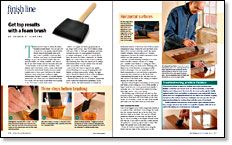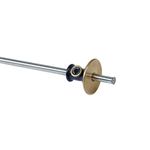Get Top Results with a Foam Brush
Foam brushes work best with varnishes, both oil and water based
Synopsis: Foam brushes cost around a dollar, are widely available, and, best of all, do not shed bristles and are discarded after use. They are the implement of choice for Thomas R. Schrunk, who explains in this article how to get the most from the tool. He details application procedures for horizontal and vertical surfaces. A short sidebar addresses avoiding bubbles and visible transition lines between strokes.
There are two ways to obtain the finest brushed-varnish finish: You can pay $50 or more for a top-quality natural-bristle brush, clean it thoroughly after each use, wrap it carefully to prevent dust buildup, and hang it to prevent bristle damage. Or you can use foam brushes that cost around a dollar, are widely available, and, best of all, do not shed bristles and are discarded after use.
Foam brushes work best with varnishes, both solvent- and water-based. In fact, foam is the brush of choice for water-based finishes because bristle brushes tend to leave more bubbles in the finish. However, avoid using foam brushes to apply solvent-based lacquer or shellac, as lacquer thinner and alcohol can soften and even dissolve the foam. If in doubt, test the brush in the finish you’re going to use; if it starts to swell, don’t use it.
Before you apply any finish, get properly set up. Begin with a clean, clear wood surface: Sand with up to P180- or P220-grit sandpaper and then vacuum the dust. On open-grained wood such as walnut, mahogany, or oak, it’s a good idea to blow the pores clear with compressed air. Finally, lightly run a tack cloth over the wood to pick up any remaining dust. Skip this step if you’re using a water-based finish because residue from the tack cloth can interfere with the finish.
One of the best ways to improve the quality of your finishing is to use good lighting that will display problems immediately. Ideally, the light source should be directly in front of the workpiece with the light hitting it at about a 45º angle.
Check the label on the can of finish to ensure that you’re within the temperature guidelines. I prefer brushing vertical surfaces at a warmer temperature, because the initial evaporation of the solvent can help prevent sags.
From Fine Woodworking #179
For the full article, download the PDF below:
Fine Woodworking Recommended Products

Odie's Oil

Veritas Standard Wheel Marking Gauge

Bessey EKH Trigger Clamps























Log in or create an account to post a comment.
Sign up Log in